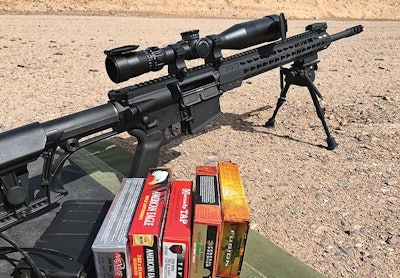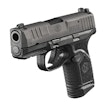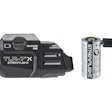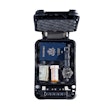 Armalite AR-10 20-inch Tactical Rifle with March Optics' scope and boxes of American Eagle, Federal, Hornady, and Nexus ammo used in the POLICE evaluation. (Photo: A.J. George)
Armalite AR-10 20-inch Tactical Rifle with March Optics' scope and boxes of American Eagle, Federal, Hornady, and Nexus ammo used in the POLICE evaluation. (Photo: A.J. George)
Founded in 1954, Armalite is as much a part of American military history as Gen. George S. Patton or the Abrams tank. You can't spark a conversation about the tried and true "black rifle" without talking about the company and its contributions to American combat weaponry.
Eugene Stoner's original design was born under the Armalite name in a .308 caliber rifle dubbed the AR-10. The AR in the name is for Armalite.
Even though the AR-10 never achieved its intended purpose of becoming the next combat rifle for the U.S. military, it did set the groundwork for the one that did.
Fast forward 60-plus years and Armalite is still doing what its always done best, making high-quality, combat-proven rifles for everyone from law enforcement officers to civilian enthusiasts. The company's current collection of AR-10 rifles retains everything that made the first AR-10 such a genius design but have been honed with 60 years of technology and innovation.
Armalite's parent company, Strategic Armory Corps, was kind enough to throw one my way for a little down-and-dirty testing to see if this workhorse of the 1950's could still get the job done.
From Barrel to Stock
My new Armalite AR-10 Tactical Rifle is a direct gas impingement, .308 caliber, semi-automatic rifle with a 20-inch barrel and a rifle-length gas system. It has iron sights and is magazine fed, just like the original. That's about where the similarities end.
The new "AR10TAC20," as it is designated by Armalite's SKU system, has several advancements that set it apart from the rest. We'll start at the "business end" of this 43-inch-long, 9.7-pound gun, work our way back, and catalog them.
The Tac20's muzzle device is Armalite's custom flash hiding compensator. This futuristic piece of machined steel not only dissipates the muzzle flash but also disperses the blast forces in such a way that the felt recoil of the gun is lighter and muzzle rise is mitigated. This means you can keep the gun on target for fast follow-up shots. The barrel this compensator is torqued onto is a 20-inch cold-hammer-forged, chrome-lined steel barrel with a 1:11.25-inch twist that has been double-lapped for accuracy. This equals a barrel that can take a serious beating yet retain accuracy greater than the average combat rifle.
The Tac20's rifle-length gas system is adjustable to allow for ammunition variations and the addition of a suppressor, something not possible on a standard direct-impingement rifle. The charging handle has been upgraded as well to a Raptor ambidextrous model with extra-large latches. I've got Raptors on all of my guns and love the oversized latches, as they provide easy grip while wearing gloves and make it much easier to work around optics. Good call, Armalite.
The receivers are both made of 7075-T6 forged aluminum for strength and durability. The upper is mated to Armalite's Key-Mod rail system that extends 15 inches beyond the breech, providing not only an absolute ton of mounting real estate but also allows for an incredibly long sight plane.
Extended distance between the iron sights allows for much more precise aiming and extends the effective range of the gun considerably without adding an optic. Speaking of iron sights, the Tac20 comes standard with a set of Magpul BUIS sights. They work OK for their intended purpose, but I wouldn't rely on them as my primary aiming devices. To get the most out of the Tac20 you'll need glass.
Moving down to the lower receiver, Armalite has added a Magpul MOE grip and an ambidextrous safety to control its proprietary two-stage precision trigger. The Armalite's first stage of travel is brief but distinct and the break, although a little gritty, is consistent. Considering what this rifle was designed to do I felt it paired quite well. Now I'm not going to debate the merits of a two-stage vs. a single-stage trigger. Personally I think it all comes down to shooter preference. Armalite's example works well, but if you'd prefer something else, there is an abundance of aftermarket drop-in designs out there.
The most obvious difference between the Tac20 and the competition has got to be the stock. Armalite has scrapped the notion of adopting an aftermarket stock as an upgrade and come up with its own adjustable precision stock. Dubbed the MBA-1, this highly adjustable and super lightweight stock was designed by LUTH-AR exclusively for Armalite rifles. Both the length of pull and comb, or cheek-weld, are adjustable to fit the individual shooter.
Think of a Magpul PRS stock, then strip away the weight and complication. Simply loosen the large thumb-wheel on the side of the skeletonized frame and adjust the stock to your liking. Tighten the screws and it is locked in place. I have to admit, this was the first thing I noticed about the Tac20 when I pulled it out of the box and at the end of the day it is still one of my favorite features.
Making It Ready
Now that I've painted a picture of the Tac20 for you, let's get down to what it can do.
As I mentioned before, to get the most out of the Tac20 you're gonna need some good glass. I found this in the form of March Optics' 2.5-25x42 illuminated tactical model with the MTR-3 reticle.
The March scope's turrets are .25 MOA adjustable with solid and positive clicks and well contoured knobs for grip, even with gloves. The illumination is via a large rubberized button at the 9 o'clock position and provides four brightness levels. The scope also comes with a large sunshade and flip-up lens caps. March threw in a pair of its high rings and I got the glass mounted and trued on the Tac20 in no time.
With the Tac20 all dressed up and ready for the ball I only needed some ammo and range time to make her dance. I was given an abundance of ammo options thanks to the good people at Federal Ammunition and augmented that with some of my agency's duty ammunition and Strategic Armory Corps' new Nexus ammo line. Here's the breakdown:
- Hornady TAP 168-grain A-Max
- Federal 168-grain Sierra Matchking BTHP
- Federal Fusion MSR 150 grain
- American Eagle 168-grain OTM
- Nexus 175grain BTHP
Before we get down to business I'll need everyone's attention, so I can throw out my usual disclaimer. My training, including my firearms training, revolves around combat and tactical applications. I am not a bench-rest shooter nor am I obsessed with the world's smallest shot groups. I am focused on what matters in my line of work; whether or not I can make the shot when it matters most with the skills and gear I currently have. As that translates to tactical precision shooting, the old adage "minute of bad guy" fits nicely. That's not to say I'm happy with 12-inch groups; there's a happy medium here. So let's see if the Armalite can rise to the challenge.
Shooting Drills
I hit the range with the Armalite, the March Optics scope, and a big box of ammo. To kick things off, I proned out at the 50-yard line to start my scope zero. March claims it mechanically zeroes all of its glass from the factory so this proved to be easier than I thought.
After a few rounds I moved back to the 100-yard line and confirmed my zero. For ease of understanding, I dialed in a true zero at 100 yards. That way, the term "MOA" makes the most sense and I'm still far enough out to get a good idea of the Armalite's accuracy abilities.
I decided to start with what I believed would be the least accurate of the ammo and loaded up a magazine of the American Eagle. I'm not saying this isn't good ammo, it's just not meant to be a precision or match grade round.
After each five-shot group, I checked my target for accuracy and gave the barrel a chance to cool. I wasn't concerned with the barrel overheating, as it is hammer forged and made to take a beating, but I did want to see what variation the cold-bore shot would produce. After all, the cold bore shot is likely going to be the most important one you ever take. With the American Eagle I was able to hold a 1.5-inch group with the cold bore consistently high left. Not bad for practice ammo and a gas gun.
I worked my way through the progression of ammunition, shooting the other two Federal examples and then moving on to the Hornady TAP. As I suspected, the Hornady and Federal Sierra rounds performed well and both posted about a 1.25 MOA group at 100 yards. To finish off the precision session, I loaded up the Nexus to see if it could live up to Strategic Armory Corps' claims. I ran three five-shot groups with the Nexus and was able to hold all three just over 1 MOA. Claims confirmed.
I dusted myself off and swapped my orange dot targets out for the usual silhouette to put the Armalite through a little more demanding course of fire. I don't abuse the guns I test, but I do put them through what I would call real-world drills to push them hard. If they're going to fail, I want it to happen on the range and not on the street. The way I see it, if my testing can produce a fatal flaw it just might keep that flaw from showing itself in the middle of your duty-related shooting.
I pulled off the March scope, switched to trusty iron sights, and moved to the 25-yard line to push the Armalite through several methodical strings of fire from various positions.
The rifle is just too heavy to be shouldering like an entry weapon but I did my best to treat it as such. The weight aside, the Tac20 performed without fail. The ambidextrous charging handle and safety were a welcome addition, especially as a lefty, and I was able to manipulate the gun with ease.
As my distance from the target decreased my rate of fire increased. By the time I was at the 10-yard line I was running rapid fire drills to push not only the limits of the gun but my skills as well. No hiccoughs, no problems, and clean, consistent targets; pretty much everything you'd like to see out of a quality combat weapon.
What's It Good For
So let's talk about what role this rifle might fill. It isn't built for long-range precision so it likely won't replace your sniper gear. Similarly it is the wrong tool for entry work so you won't be turning in your SBRs anytime soon. Where I can see its true value would be as an intermediate or overwatch weapon, perhaps in the turret of an armored vehicle.
For this role, you need something with enough accuracy to make precise shots at 100 yards or less and with a round heavy enough to pass through barriers and still remain effective. The Tac20 fits this role, and it is light enough to hastily deploy and durable enough to take a beating.
If you've got such a niche on your tactical team or even in your patrol vehicle take a good look at the Armalite Tac20. The quality is unquestioned, and at a retail price of $2,099, it is a great value.
A.J. George is a sergeant with the Scottsdale (AZ) Police Department assigned to the Technical Operations Unit, Special Investigations Section.














